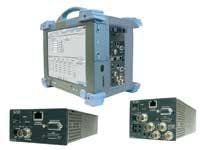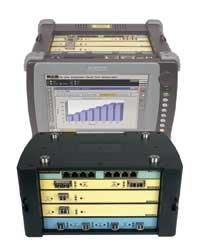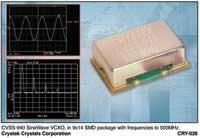test equipment
For next generation Ethernet over SONET/SDH service emulation, analysis, and troubleshooting, the FTB-8100 analyzer’s additional functionalities include support for low-order virtual concatenation (VCAT) and link capacity adjustment scheme generation and analysis, differential delay insertion capabilities for both high-order and low-order VCAT, and full remote testing and monitoring capabilities via a standard Ethernet LAN connection. The analyzer combines advanced DS-n/PDH, SONET/SDH, and next generation SONET/SDH test functions in a single unit. Suited for field, central office, and lab applications, each analyzer includes a multirate Ethernet add/drop interface.
EXFO Electro-Optical Engineering, Quebec City, www.exfo.comThe STT Ethernet module is designed for the qualification, installation, maintenance, monitoring, and troubleshooting of metro networks from 10/100 Mbits/sec to 1- and 10-Gigabit Ethernet, plus 1- and 2-Gbit/sec Fibre Channel. Its application-based Windows user interface optimizes testing time and minimizes time spent on test configuration and training. The module covers BER and throughput testing across Layers 1, 2, and 3 and includes powerful packet decoding all the way to Layer 7.
Sunrise Telecom, San Jose, CA, www.sunrisetelecom.com
‘One-to-one’ design FTTH delivery systems
Using a “one-to-one” design particularly geared to new construction where the number of potential subscribers is initially small rather than a “shared” media-converter architecture designed for large systems, the LightHouse FTTH series is a standards-based broadband delivery system optimized for multidwelling units, gated communities, and small municipalities. It provides transport of 10/100Base-T Ethernet and 54-870-MHz cable TV bandwidth to each premises through one singlemode fiber. Employing PON technology so there is no active equipment required between the headend and premises, the FTTH system comprises cable TV optical transmitter, amplifier, couplers, headend media converters, and premises media converters. Advanced services such as VoIP, IP video, VoD, and digital cable are supported.
Blonder Tongue Laboratories,Old Bridge, NJ,www.blondertongue.comCompact, flexible mode conditioning plug
The small, compact, and very flexible mode conditioning (MC) plug eliminates the need to buy a specific MC patch cord since the existing patch cord is used. The need for mode conditioning is due to the singlemode launch characteristics of the LX long-wavelength (1300-nm) transceiver modules typically used in 1000Base-LX systems. Launching these VCSEL-based transceivers directly into multimode fiber (MMF) can generate multiple signals causing confusion at the receiver, especially in lengths of >300 m. By precisely fusion splicing singlemode fiber (SMF) to MMF within the MC plug, light from the transceiver is launched into the MMF that is offset from the center of the SMF. That simulates a typical LED launch and eliminates the potential issues caused by multiple signals. Compliant with the 802.3z IEEE standard, the plugs come in SC or LC styles and with 50/125- or 62.5/125-µm MMF.
For 10-Gigabit Ethernet, broadband, SONET/SDH, network/switch, and ATM communications, the CVSS-940 true sinewave voltage-controlled crystal oscillator (VCXO) provides low-phase -150 dBc/Hz noise floor performance and +50-ppm minimum APR pullability. The VCXO generates frequencies between 77.760 and 500 MHz, with output level of 0 dBm minimum into 50 Ωand harmonics <-20 dBc. It also consumes 25-mA typical and 30-mA maximum current at 3.3 V and has low or no sub-harmonics due to the use of Inverted Mesa (high-frequency) technology. Available in the industry-standard 9×14-mm SMD package, the VCXO is suited for industrial and other rugged applications in the extended operating-temperature range of -40° to +85°C.
Crystek Crystals, Ft. Myers, FL, www.crystek.com
GbE SFP-based plug-in transponder
The Double Dual Gigabit Ethernet SFP-based transponder for the TM-Series (formerly Mentis) platform allows the deployment of small-footprint fully integrated metro WDM nodes, enabling backhaul of GbE traffic generated by DSL and cable-based broadband access systems. The plug-in card supports four GbE signals electrically multiplexed into two wavelengths, with optional 1+1 protection on each wavelength. It can be installed in any TM-Series chassis, creating a compact WDM node with add/drop optical filters, multiple GbE client signals, protection, and in-band management capabilities. A built-in repeater function allows cascaded nodes to extend system reach to multiple spans, with each span up to 100 km. The card is best suited for triple play services, where operators need high bandwidth to transfer TV, telephony, and Internet services over an IP network. Expansive performance monitoring and GbE utilization moni toring allows operators to monitor and bill on a capacity usage level.
Transmode, Stockholm,
www.transmode.com
Optical LAN termination kit
The Xpress electricity-free termination kit provides fast and reliable LC, SC, and ST connector terminations for optical LANs. With an operating temperature of -10° to +60°C, the kit is suited for indoor applications like bare fiber device testing and for datacom systems like LANs, data networks, and fiber restoration. It comes with 12 connectors, adhesive, accelerant, stripping template, and an abbreviated termination procedure. The kit installs in about 3 minutes, or up to 50% faster, and uses standard fiber-optic assembly tooling. By applying a drop of accelerant onto the connector endface and placing the adhesive directly onto the fiber, an almost instantaneous bond is created between the fiber and ceramic ferrule. The adhesive does not require measuring, mixing, an applicator, or heat curing.
Molex, Lisle, IL, www.molex.com
10-GbE, optical CDMA design software
The OptSim 4.5 optical communications design suite now supports new applications for optical CDMA and 10-Gigabit Ethernet multimode systems. It also includes several technical advances such as stimulated Brillouin scattering modeling, which simulates the interaction of light with acoustic waves within optical fibers, and enhanced interfaces with the photonics component design suite. The software enables the user to enhance the spectral efficiency and reduce the multiple-access interference of optical CDMA systems. Multimode-fiber manufacturing imperfections and component misalignments can be taken into account to assess the performance and optimize the design of 10-GbE multimode systems based on the IEEE 802.3ae standard. New documentation, application notes, and examples on both FTTH/FTTP and FSO communications systems are included. Users can optimize the fiber length, splitting ratio, and number of ONT units for FTTH/FTTP systems employing PON architectures and account for the turbulences of free-space signal propagation to study the performance variation and optimize the geometry of FSO links.
RSoft Design Group, Ossining, NY,
www.rsoftdesign.com





